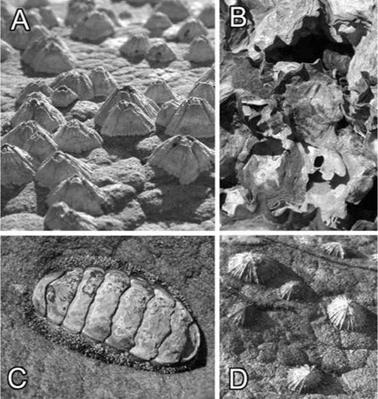Many marine organisms are able to secrete glues, which can act in aquatic environment (Figure 8.82 and Table 8.10). Flatworms (turbellarians), annelids and gastro — trichs (worm-like animals) use glandular organs composed of three cell types: two distinct gland types and specialized epidermal cells for secretion discharge (Figure 8.82) [86]. The dual function of these glands leads to the term ‘duo-glands’.
|
Figure 8.82 Gluing underwater. (A) barnacles and (B-D) mollusks on the rock substrate. (A) barnacles Tesseropora rosea; (B) rock oyster Saccostrea glomerata; (C) chiton Acanthopleura gaimardi; (D) common limpet Cellana tramoserica. |
|
Table 8.10 Tenacity of some marine invertebrates on smooth glass [85].
|
This triplet of structures, usually operating with three distinctive functions of adhesion, de-adhesion and tension bearing, is recognized in most marine organisms.
It has also been suggested that marine organisms adhere by the secretion of polycationic substances, which bind to substrates, especially to anionic sites [87]. The actual mechanism of adhesion depends on the chemistry of secretion. The attachment systems of polychaete larvae use lectins as adhesives, whereas the majority of other systems bear proteins and glycans (glycoproteins, protoglycans, polysaccharide protein complexes). Systems adapted for permanent adhesion, such as those found in mussels and barnacles, bear proteins and polyphenols (Figure 8.82) [88-92]. Polyphenols play a role in tanning proteinaceous components of the secretion. The variety of adhesive systems, based on two-component adhesion, shows that there is no universal duo-gland mechanism [86].
In systems using adhesive substances as a form of viscoelastic lubricant for locomotion, glycans are the main component (Figure 8.83). These adhesives, which have been reported in molluskan pedals and echinoderm tube feet, are known as ‘mucus’. Due to its viscoelastic properties, mucus behaves as an elastic solid under rapidly applied forces (adhesive function), but as a flowing fluid at slow velocities (lubricating function) [93, 94].
 16 января, 2016
16 января, 2016  Pokraskin
Pokraskin 
 Опубликовано в рубрике
Опубликовано в рубрике 